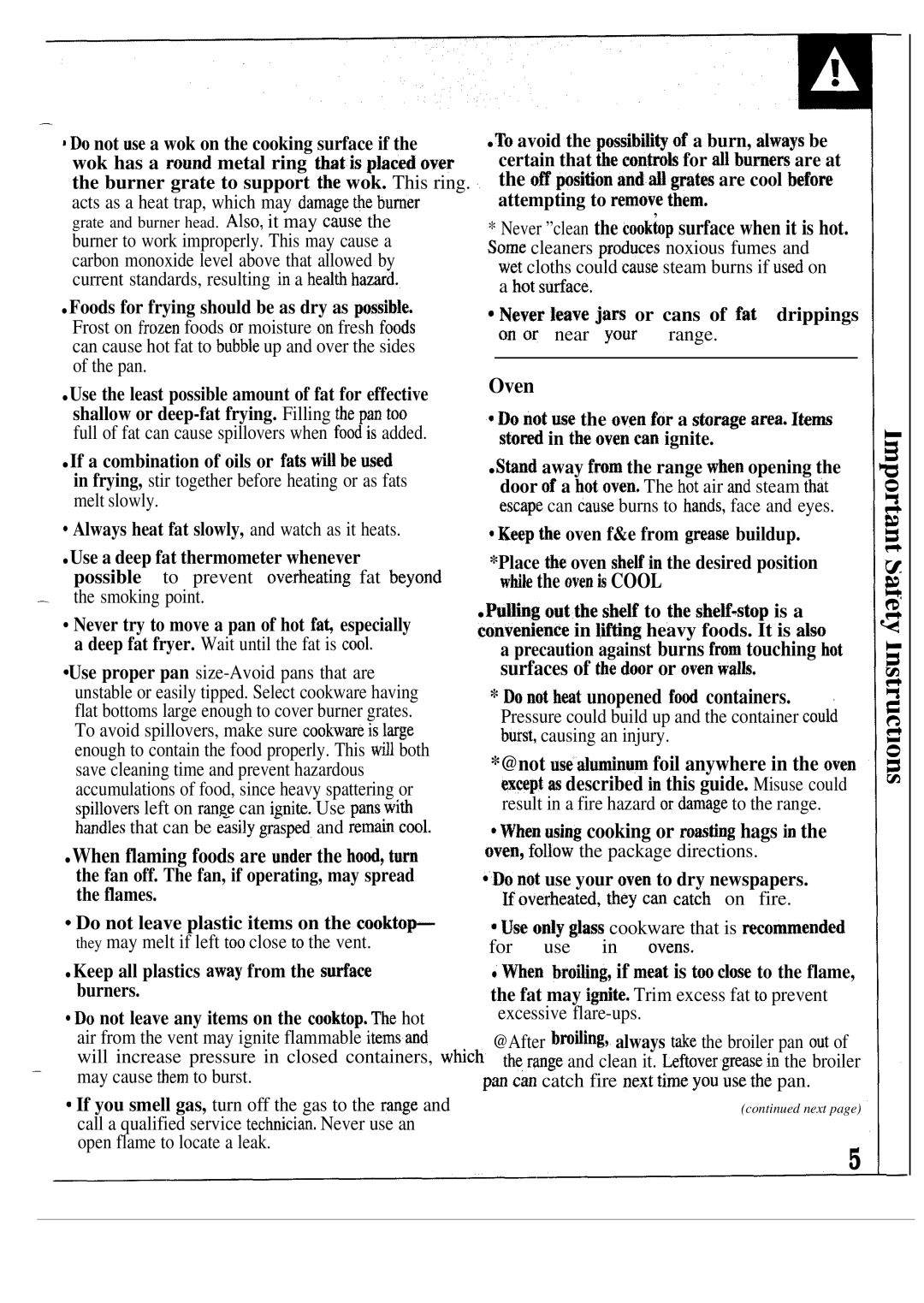
.
~Do not use a wok on the cooking surface if the wok has a round metal ring thatis placed over the burner grate to support the wok. This ring. ![]() ~~•
~~•
acts as a heat trap, which may damage @e burner
grate and burner head. Also, it may cause the
burner to work improperly. This may cause a carbon monoxide level above that allowed by current standards, resulting in a heal~ h~~d.,
●Foods for frying should be as dry as possibh Frost on frozen foods or moisture on fresh foods can cause hot fat to bubble up and over the sides of the pan.
●To avoid the possihiiity of a burn, always be certain that the eontrois for all burners are at the off positian and.aii grates are cool before
attempting to remove them.
,
*Never ”clean the cooktop surface when it is hot.
Some cleaners produces noxious fumes and wet cloths could cause steam burns if us~d on a hot surfacfi.
*Never l~ave jars or cans of fat drippings
cm 0$ near your range.
.
—
● Use the least possible amount of fat for effective | Oven |
|
|
| |
shallow or | ~ Do tio$ use the oven ftir a storage area+ Items | ||||
full of fat can cause spillovers when fcmd is added. | stored in th~ oven can ignite. | ||||
● If a combination of oils or ft+ts wiil be used | ● Stand away from the range when opening the | ||||
in frying, stir together before heating or as fats | |||||
door ot’ a hot oven. The hot air and steam that | |||||
melt slowly. | escape can cause burns to harids, face and eyes. | ||||
c Always heat fat slowly, and watch as it heats. | * Kwp the oven f&e from grease buildup. | ||||
● Use a deep fat thermometer whenever | *Place $h~ oven sheif in the desired position | ||||
possible to prevent oveheahg fat beyond | while the oven is COOL | ||||
the smoking point. | ● Pulling out,the shelf to ,the | ||||
● Never try to move a pan of hot fat especially | |||||
tmnvenience in l~fting heavy foods. It is also | |||||
a deep fat fryer. Wait until the fat is cool. | a precaution against burns froin touching hot | ||||
Use proper pan | surfaces of th~ door or oven wails. | ||||
unstable or easily tipped. Select cookware having | * IJa not heat unopened foiid containers. | ||||
flat bottoms large enough to cover burner grates. | Pressure could build up and the container could | ||||
To avoid spillovers, make sure cookware is large | |||||
burst, causing an injury. | |||||
enough to contain the food properly. This will both | *@not use’’’aiuminu~ foil anywhere in the ovm | ||||
save cleaning time and prevent hazardous | |||||
accumulations of food, since heavy spattering or | exc~pt as described in this guide. Misuse could | ||||
s~illovers left on range can ignite. Use pans w~th | result in a fire hazard or damage to the range. | ||||
~andles that can be &sily gr&ped and ;ernain cool. | * When using cooking or mmsting hags in the | ||||
● When flaming foods are under the htmd~ turn | Oven$ follow the package directions. | ||||
the fan off. The fan, if operating, may spread | |||||
the flames. | Ifcwerheated, they can catch on fire. | ||||
Q Do not leave plastic items on the cooktop— | * Use only glass cookware that is recomnwmded | ||||
they may melt if left too close to the vent. | for | use | in | ovem. | |
● Keep all plastics away from the surface | i wh~~ | broiling, if meat is too close to the flame, | |||
burners. | the fat may ignife. Trim excess fat to prevent | ||||
* Do not leave any items on the cooktop. The hot | excessive |
| |||
air from the vent may ignite flammable iternsand | @After ‘broiling,, always take the broiler pan out of | ||||
will increase pressure in closed containers, which thq mnge and clean it. Leftovergrease in the broiler
may cause them to burst. | pan can catch fire nexttimeyou usethe pan. |
Q If you smell gas, turn off the gas to the range and | (continued next page) |
call a qualified service technician, Never use an |
|
open flame to locate a leak. |
|
5
